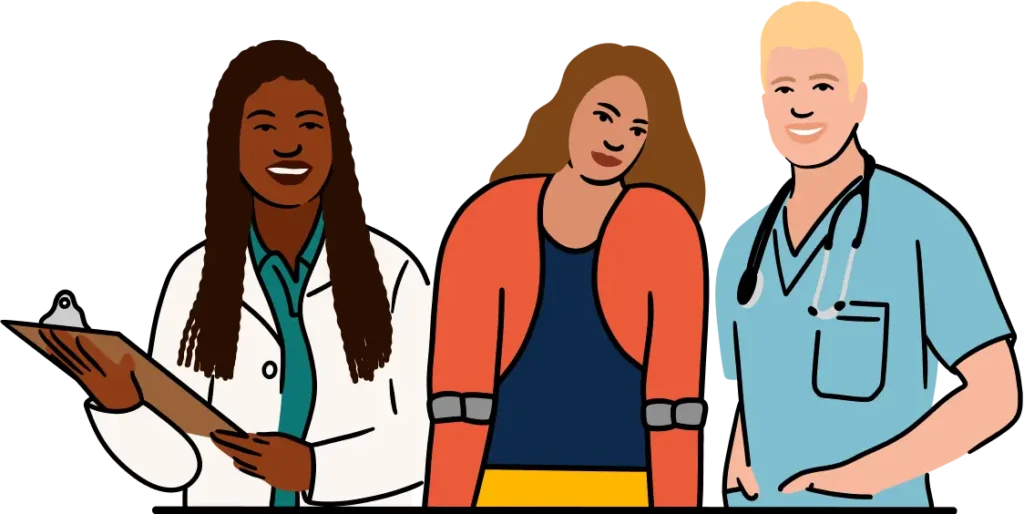Changing How Healthcare is Paid For
Making IDD Visible
Making IDD Visible is a project that will use artificial intelligence (AI) to help people with intellectual and/or developmental disabilities (IDD) by:
Identifying them better in clinical and insurance claim data
Addressing unfairness in their healthcare
Creating a healthcare system that is more supportive and works better for them
Changing How Healthcare Data is Used to Pay for the Right Services
IEC understands that better data is very important to start improving life for people with IDD. Better data will:
--Give correct information about how many people have IDD
--Help people with IDD get the services they need
--Stop doctors from making bad choices
Making IDD Visible will create e-IDD. e-IDD is an AI tool that will:
--Look at clinical and billing data
--Help find children and adults who are likely to have IDD
We will create e-IDD using information from over 1,000 patients. We will work with people with IDD, doctors, data experts, and ethics specialists.
The tool can be used by doctors, insurance companies, the government, researchers, and other groups that follow the rules for using it properly and respectfully.
e-IDD will give people with IDD more control, help doctors and patients have better talks, and work to make healthcare more fair.
- 1 in 20 Americans have IDD
- 10x: how much people with IDD are undercounted in insurance claims and electronic medical records
- 1 in 4 people with a disability do not have a regular healthcare provider
- $350 billion: annual cost of care spent on the wrong services that don’t improve people’s health
Why This Matters
You can't help someone if you don't know they exist. Right now, many people with IDD are not properly identified in regular healthcare data.
Surveys and information from the CDC show that the real number of people with IDD could be about 20 times higher than what insurance claims and electronic medical records currently show. The data shows 1 to 3 people per 1,000 have IDD.
But the true number is likely 30 to 50 people per 1,000 have IDD.
These missing pieces of information have big effects. They:
--Prevent people with IDD from getting the resources they need to do well
--Cause doctors and insurance companies to make choices that can lead to harm
--Make healthcare leaders wrongly think that there aren't many people with IDD and their needs aren't important
People with IDD are invisible in data because:
--Doctors don't check for or diagnose IDD enough
--People with IDD don't always mention their diagnosis because they worry about negative results
--Medical records don't always follow a patient, especially as they become adults
People with IDD deserve to be seen, heard, and supported.
Making IDD Visible will speed up work to fix the unfairness people with IDD face in getting good healthcare. It will help:
--Measure health results that matter to people with IDD better
--Create a real understanding of how people with IDD use healthcare
By:
--Aiming services where they're needed most
--Finding patterns in spending
Making IDD Visible will open the door for important investments in a healthcare system that is able to meet the unique needs of people with IDD.
Making IDD Visible Highlights
2022
Created a main team including Duke University, Montefiore Medical Center, Intel, Nationwide Children’s Medical Center, and Jefferson Health.
2023
Added an advisor and people with IDD to our main team.
Finished making a detailed list of ICD-10 codes. ICD-10 is a system used by doctors to classify diseases. The codes we listed define the IDD population. We made this list by working together with:
--People who have personal experience with autism and intellectual disabilities
--Doctors who have experience treating children and/or adults with autism and intellectual disabilities
We also did some early analyses using electronic health record data.
Phase 2 (TBD)
Finished analyzing private insurance claims data with Milliman, a healthcare data company and created a plan to:
--Describe how people with IDD might show up in the data
--Find possible sources of bias in the data
--Deal with ethical concerns about how e-IDD should be created and used
Making IDD Visible Partners
The Making IDD Visible team includes people with IDD, their care partners, doctors, and other healthcare leaders. This diverse group works together based on listening to the real-life experiences of people with IDD and healthcare professionals. They use these perspectives to create practical solutions to improve healthcare.
Click on each to expand
Project Lead
- Mai Pham, President and CEO, IEC
Partners
- Duke University
- Epic
- Jefferson Health
- Montefiore Medical Center
- Nationwide Children’s Hospital
- Self-Advocates
Team on Insurance Claims Analysis
- Harsha Mirchandani
- Pamela Pelizzari
- Ian Moura
- Jennifer Kucera
- Gary Maslow
- Michelle Franklin
Making Healthcare Better and Safer for People with IDD
IEC works with people who have personal experience living with IDD and healthcare professionals. Together, they create new programs focused on patients' needs to change how healthcare is taught, provided, and paid for.




